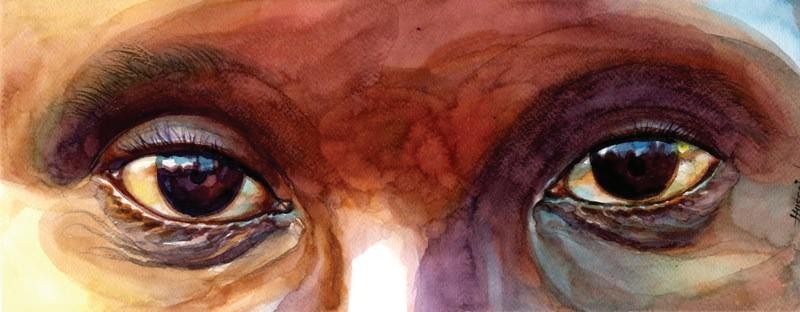REPORT
ILLUMINATING SHADOWS: THE UNTOLD IMPACT OF THE SUDAN CONFLICT ON ETHIOPIAN AND ERITREAN REFUGEES
Strategic Initiative for Women in the Horn of Africa
DISCLAIMER
This publication was produced with funding from the Swiss State Secretariat for Migration. However, the views expressed and the content included do not imply official endorsement or acceptance by the Swiss State Secretariat for Migration or their affiliated organizations.
Cover artwork: Hussein Salim
Design: Marce Digital
Published: June 2024
No part of this publication may be reproduced, stored in a retrieval system, or transmitted in any form or by any means without prior approval in writing from The Research Team and SIHA Network. This Paper is not a legally binding document. It is a collaborative informational and assessment document and does not reflect the views of any of the contributing partners in all its contents. Any errors are the sole responsibility of the authors.
Copyright © 2024 SIHA Network
INTRODUCTION:
In April 2023, war broke out across Sudan. Sudan’s recent armed conflict has precipitated one of the most rapid crises on a global scale, affecting millions and creating a dire humanitarian situation. Almost 25 million people are projected to be in need of basic assistance in 2024 as a result of the conflict, with only 14.7 million targeted by OCHA for assistance in 2024.1 The conflict has led to unprecedented displacement, with 8 million people uprooted and over 6.5 million internally displaced within Sudan, seeking refuge in various locations. This exodus has extended beyond Sudan’s borders, with approximately 1.2 million fleeing to neighboring countries, escalating the crisis to the largest displacement event worldwide.2
This crisis has exacerbated an already critical situation in which civilians face not only violence but also risks related to food insecurity due to disruptions in agricultural systems alongside disruptions in food trading systems. The Food and Agriculture Organization notes that a third of the population, roughly 18 million people, are facing acute food insecurity in this coming year. This represents the highest number recorded during a harvest season and highlights the scale of damage and disruption in Sudan’s agricultural regions.3
For decades, Sudan has served as a haven for tens of thousands of Eritrean and Ethiopian refugees fleeing conflicts and droughts in their homelands. Many Eritreans sought refuge from the prolonged conflict with Ethiopia, which eventually led to Eritrea’s independence in 1993. Moreover, many Ethiopians came, first as labor migrants and later as refugees in the wake of the 2021 war in Tigray as well as the ongoing wars in Amhara. This history of displacement saw a significant number of Eritreans and Ethiopians making Sudan their home, with the influx of refugees notably increasing during times of intensified conflict and hardship.
With the outbreak of hostilities in Sudan on April 15, a reversal of this long-standing migration pattern has emerged. Over 47,000 refugees and asylum seekers, predominantly Ethiopians who had found refuge in Sudan, have returned to Ethiopia.4 Others have remained in Sudan, facing unstable conditions, disrupted
1 https://reports.unocha.org/en/country/sudan/
2 https://data.unhcr.org/en/situations/sudansituation Accessed April 2, 2024
3 https://www.fao.org/newsroom/detail/sudan-fao-issues-stark-warning-over-deeply-concerning-scaleof-hunger/en
4 https://www.aljazeera.com/news/2024/1/31/nearly-eight-million-people-displaced-by-war-in-sudan-un
access to livelihoods, and the same humanitarian and security menaces faced by Sudanese citizens. This group includes Eritreans who had sought safety in Sudan and cannot return to their country, now facing the prospect of displacement yet again.
Sudanese communities, historically sharing scarce resources with refugees, continue to provide support amidst their challenges. However, the situation remains dire, with essential needs such as health facilities, safe drinking water, access to livelihoods, and education remaining pressing issues. Many refugees, despite the current turmoil, hold onto the hope of returning to their homelands when peace and stability are restored. Currently in Sudan, Eritrean and Ethiopian refugees face particular challenges related to their legal status, including the loss of essential documents and an inability to receive replacements. These challenges exacerbate already existing challenges, including harassment and arbitrary detention by authorities, harassment and arbitrary detention by authorities, as well as exacerbated vulnerability to exploitation both within Sudan as well as while encountering smugglers and criminals attempting to leave.
THE SITUATION OF ERITREAN AND ETHIOPIAN REFUGEES IN SUDAN BEFORE THE WAR
Prior to the war, Sudan hosted approximately 1.1 million refugees, including over 125,000 from Eritrea and 69,500 from Ethiopia. These refugees included over 50,000 newer arrivals who had come from Ethiopia due to the war in Tigray. It also included those who had arrived in Sudan some time before, most notably Eritreans who had come over the course of the prolonged war with Ethiopia which led to the independence of Eritrea in 1993.5 In addition to refugees, there exited a population of Ethiopians who came as labor migrants, coming both to be connected with family already in Sudan as well as for work opportunities.6 These migrants were at times documented with access to residency permits and essential documents by the Sudanese government and at times undocumented, limiting their access to essential services.
5 https://reliefweb.int/report/sudan/sudan-fact-sheet-september-2021
6 https://dtm.iom.int/reports/ethiopia-flow-monitoring-survey-report-4-august-october-2020
Prior to the war, Ethiopian and Eritrean women, regardless as to their legal status, primarily worked in fields of domestic labor, tea and food serving, and market work selling particular products such as perfumes and beauty products. This was in part because, as noted in studies of these populations, many of these women had limited access to education, getting a basic primary education or no education at all, consequently limiting the access of many to more specialized forms of work.7
Both refugees and labor migrants resided in eastern Sudan, where many refugees lived in refugee camps as well as in urban areas, as well as in Khartoum. While Sudan is a member of the 1951 Convention Relating to the Status of Refugees and its 1967 protocol, as well as the African Union Convention Governing the Specific Aspects of Refugee Problems in Africa, it has long held a reservation of Article 26, regarding freedom of movement.8 This reservation has played out in terms of policy in that the Sudanese government at many points implemented regulations that required refugees to remain in refugee camps at the border.9 Those that left the camps risked being imprisoned and returned to the camps if they were found outside, limiting their access to services and creating vulnerabilities, particularly for refugee women who faced greater risk of exploitation and sexual violence. Furthermore, this policy meant that even those Ethiopians and Eritreans not registered as refugees, whether without documentation or with work permits or residency, also faced suspicion and increased risk of imprisonment from authorities under suspicion of having violated encampment policies.
Moreover, those refugees who lived outside of the camps had limited access to resources or support from organizations, who focused the bulk of their efforts at providing services in the camps, even while struggling to gain adequate income for their families. The educational backgrounds and challenges of operating in an entirely different language meant that Ethiopian and Eritrean women had serious challenges accessing critical services such as healthcare facilities or educational facilities for themselves or their families. In addition, their status opened themselves up to harassment from state authorities, with Ethiopian and Eritrean women and men subject to arbitrary arrests and harassment on the pretext that they might be undocumented. Refugees were often subject to violence as well in the process of coming to Sudan, with cases of abductions and hostage taking by smugglers.
7 Noted in consultant report, interviews, and IOM fact sheet above. 8 https://treaties.un.org/pages/ViewDetailsII.aspx?src=TREATY&mtdsg_no=V-2&chapter=5&Temp=mtdsg2&clang=_en#EndDec
9 “Sudan - Country Refugee Response Plan (CRP) - January - December 2021,” pages 6-7. https://data. unhcr.org/en/documents/details/85783
THE EFFECTS OF THE WAR ON ETHIOPIAN AND ERITREAN WOMEN
Following the outbreak of war in April 2023, Ethiopian and Eritrean women who were in Khartoum were caught in the war alongside Sudanese civilians and faced increased risks of sexual violence in the war due to their identities and economic and social vulnerability. Stereotypes persistent in Sudan regarding the sexual availability of Ethiopian and Eritrean women meant that armed parties were more likely to target Ethiopian and Eritrean women for sexual violence. In addition, the prevalence of Ethiopian and Eritrean women in jobs as domestic labor left them isolated in Sudanese households when the war broke out. During the initial two months of the war, SIHA relocated a number of Ethiopian and Eritrean women and their families from Khartoum to eastern Sudan. All of the women who were relocated had worked as domestic labor in Sudanese households and had been left behind alone in their employer’s homes, placing them at particular risk for sexual violence. Of them, six reported that they had been raped in their employer’s homes prior to their relocation.
In addition, SIHA has documented eleven cases of Ethiopian and Eritrean women being subject to rape, with most of those occurring in the first month of the war. These numbers do not represent a total number—most women facing rape at that moment did not report it—but rather show a pattern where Ethiopian and Eritrean women in Khartoum and later in Gezira following the invasion of the Rapid Support Forces into the area faced sexual violence from soldiers. Following their movement away from areas controlled by the RSF, Ethiopian and Eritrean women report facing a second threat, however, from the Sudanese Armed Forces, which suspects them as collaborating with the RSF and detains them and menaces them on that basis.10
Since then, Ethiopian and Eritrean women have remained in Khartoum even as the war has persisted, particularly in the neighborhoods of al Daim and Sajjana, where Ethiopians and Eritreans have lived for decades. There, they have continued to face harassment and assault from the Rapid Support Forces. Resistance Committees in the area report incidents of violence and sexual violence ongoing against civilians. In the first week of March 2024, a tea seller and mother of two was shot by the RSF and eventually succumbed to her wounds despite efforts to save her. Moreover, on March 12, 2024, resistance committees reported that the RSF forcibly entered the home of an Ethiopian family and attempted to rape one of the daughters in the household. After seeking help from the neighbors, the family was eventually forced to relocate for the night due to multiple returns by the assailant.
10 National consultant report.
The outbreak of war and the displacement and loss of belongings was particularly damaging for Ethiopian and Eritrean women not only because of their economic precarity, having amassed very little savings and with limited access to cash, but also due to the loss of critical documents. Many of those displaced due to the war either lost or had their documents destroyed; this included their IDs and marriage certificates, divorce certificates, and documentation of their children. With the closure of the Khartoum office for permit renewals, this has meant that many were unable to gain new documentation proving their identity or legal status in the country or documents to provide the option to return to their countries, placing them at greater risk for harassment and detention by authorities. Similarly, the loss of marriage certificates has high stakes for women, who have been brought before the police under accusation that the man they lived with was not in fact their husband.
Many of those displaced from Khartoum or other parts of Sudan have fled to the East, either to Kassala, Gedarif, or Port Sudan areas, or over the border into Ethiopia. Roughly 47,000 refugees and asylum seekers, most of whom were Ethiopian or Eritrean, have gone to Ethiopia since the war began.11 Others who have remained in Sudan have applied for repatriation, such as one of those interviewed by SIHA who noted that the International Organization for Migration (IOM) and the United Nations High Commissioner for Refugees (UNHCR) had provided some financial assistance and facilitated our registration for voluntary repatriation. However, to date, none of us have been repatriated. Others were forced to leave unwillingly, with a number of Eritrean women and girls who were refugees or refugee students forced by security authorities to return to Eritrea without their knowledge or consent, since they were told that the bus would be going to Kassala. This was undertaken in violation of international law against refoulment, since those who leave Eritrea without authorization face prosecution from the state upon return.12
Those who have resettled in the East face extreme economic hardship due to the loss of their possessions. As part of this report, SIHA has interviewed a number of Eritrean and Ethiopian women affected by the war. One noted that: “The war has stripped me of everything. I lost my job, my possessions, and my belongings. It deeply wounded me, as I was humiliated due to financial constraints.” Another recounted that “We’ve fled from war and came to find war also here in all of Sudan.” As one commented: “In Khartoum, I worked in houses and I made decent money, but when the war came, I wasn’t able to take all the money with me.”
11 https://www.aljazeera.com/news/2024/1/31/nearly-eight-million-people-displaced-by-war-in-sudan-un 12 National consultant report
Economic insecurity due to the disruptions of the war and the rising prices, even in the East, has led to many being unable to continue with their livelihoods. The refugee above noted that “when the war came to Khartoum and Medani, no one was working. People came to see from their brothers who had a little money to take a loan so that they could buy tea so that they could sell it, but the work didn’t cover the costs because people wouldn’t come to buy coffee and tea since the customers didn’t have money themselves. And the prices for material increased every day. Who can buy tea?” Another recounted “I came to Kassala, and they said to work as a food server, but there was no work, no transportation, no people came to eat—they said that the money all went to renting a house and the Sudanese and Ethiopians couldn’t buy food.”
Their stories point to increased challenges marked by the dangers facing all those in Sudan as well as the increased precarity that many Ethiopian and Eritrean women face. In this context, several of the women that SIHA interviewed for this report noted that they had heard of sexual exploitation occurring, with Ethiopian and Eritrean women forced by economic insecurity and the need for adequate living conditions, including food and shelter.
Another recurrent issue was the lack of adequate medical care access due to the war. With the mass displacement from Khartoum and the closure of medical facilities, including those facilities accessible to Eritrean and Ethiopian women, Eritrean and Ethiopian women have found themselves with extremely limited access to medical care, both due to lack of funds and lack of facilities. One recounted to SIHA that “In Medani, we were very tired because we went by foot often on the street. Many of our relatives had health problems like diabetes or blood pressure and got sick when we arrived. We said we’d go look for a hospital, but we found the hospitals were all full of Sudanese people and no one could meet a doctor.” with another describing leaving Khartoum for Atbara to seek treatment before eventually travelling to Kassala and another still noting her brother died during the war due to untreated illness. Those displaced to the East who have sought care have been forced to contend with extremely limited facilities that are overstrained due to the influx of patients from Khartoum.
These risks and concerns were also present even for Eritrean and Ethiopian women married to Sudanese men. Reports have made clear that in some cases, Eritrean and Ethiopian women who accompanied their husbands to their villages were rejected by their husbands’ families and eventually forced to leave. Others were left
by their husbands in Khartoum, when they went to their villages without them. This has meant that in those cases, Ethiopian and Eritrean women have been displaced to the East on their own.13
RECOMMENDATIONS
In the wake of this war and in light of the massive disruptions and dispossessions experienced by Ethiopian and Eritrean women, it is essential that further efforts at intervention focus on protection. This includes:
◆ UNHCR and the International Organization for Migration (IOM) should offer assistance to women and girls who are refugees affected by the war in Sudan. This should include providing relocation services to refugee camps and facilitating their return to their home countries when desired.
◆ Refugee women are subjected to conflict-related sexual violence and profiling by warring parties that makes them particularly vulnerable. They should have access to sexual and reproductive health services and social support in refugee camps as well as in locations outside of the camps where many of them are located.
◆ Ethiopian and Eritrean women and underage girls have faced abduction and disappeared during the war, as well as serious challenges to their security including imprisonment on accusations regarding lack of documents. There is a need to create mechanisms among national and international organizations to track forced disappearance, sexual violence, and other forms of violation committed against women refugees in Sudan as well as to provide them with access to justice, including lawyers.
◆ Refugee women and girls present in refugee camps should be encouraged to form women and girl’s associations. They should also be provided with small resilience funds and when economically feasible, income generation support to enable them to sustain themselves and maintain their mental health.
13 National consultant




